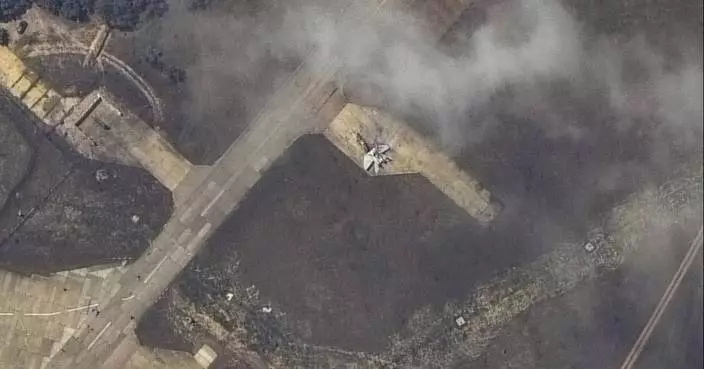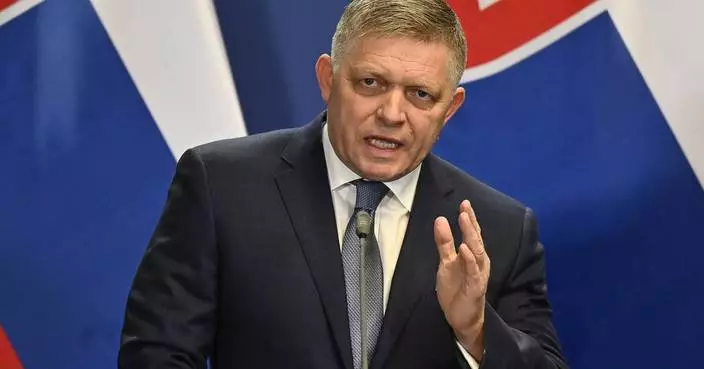LONDON (AP) — A British police officer pleaded guilty Thursday to terror charges for showing support on social media for Hamas, which is designated a terror group and banned in the U.K.
West Yorkshire constable Mohammed Adil admitted sharing two images on WhatsApp supporting the group three weeks after Hamas and other Palestinian militants stormed into Israel on Oct. 7 and killed about 1,200 people and seized some 250 hostages.
Adil, 26, pleaded guilty in Westminster Magistrates’ Court to two counts of publishing an image in support of a proscribed organization in violation of the Terrorism Act.
In messages shared on WhatsApp stories with nearly 1,100 contacts, Adil posted images of a fighter wearing a Hamas headband, prosecutor Bridget Fitzpatrick said.
“Today is the time for the Palestinian people to rise, set their paths straight and establish an independent Palestinian state,” an Oct. 31 post said, apparently quoting the leader of Hamas’ military wing.
A second post on Nov. 4 was said to quote a Hamas military spokesperson.
Two other police officers who were concerned by the images reported Adil to superiors, Fitzpatrick said. He was arrested in November and has been suspended from the force.
“I accept that at the time of the offending you were of good character,” Chief magistrate Paul Goldspring told Adil, though he said he may impose a prison term when he is sentenced June 4.
Adil was released on bail.

West Yorkshire Police officer Mohammed Adil, 26, leaves Westminster Magistrates' Court in central London, Thursday May 2, 2024, after he admitted two counts of publishing an image in support of Hamas, which is banned and designated a terror group in the U.K., the Independent Office for Police Conduct said. (Victoria Jones/PA via AP)
WASHINGTON (AP) — Trucks carrying badly needed aid for the Gaza Strip rolled across a newly built U.S. pier and into the besieged enclave for the first time Friday as Israeli restrictions on border crossings and heavy fighting hindered the delivery of food and other supplies.
The shipment is the first in an operation that American military officials anticipate could scale up to 150 truckloads a day, all while Israel presses in on the southern city of Rafah in its 7-month offensive against Hamas.
But the U.S. and aid groups warn that the floating pier project is not a substitute for land deliveries that could bring in all the food, water and fuel needed in Gaza. Before the war, more than 500 truckloads entered the territory on an average day.
The operation's success also remains tenuous because of the risk of militant attack, logistical hurdles and a growing shortage of fuel for the trucks to run due to the Israeli blockade of Gaza since Hamas' Oct. 7 attack. Militants killed 1,200 people and took 250 others hostage in that assault on southern Israel. The Israeli offensive since has killed more than 35,000 Palestinians in Gaza, local health officials say, while hundreds more have been killed in the West Bank.
Aid agencies say they are running out of food in southern Gaza and fuel is dwindling, while the U.S. Agency for International Development and the World Food Program say famine has already taken hold in Gaza’s north.
Troops finished installing the floating pier on Thursday, and the U.S. military's Central Command said the first aid crossed into Gaza at 9 a.m. Friday. It said no American troops went ashore in the operation.
“This is an ongoing, multinational effort to deliver additional aid to Palestinian civilians in Gaza via a maritime corridor that is entirely humanitarian in nature, and will involve aid commodities donated by a number of countries and humanitarian organizations,” the command said.
The Pentagon said no backups were expected in the distribution process, which is being coordinated by the United Nations.
The U.N., however, said fuel deliveries brought through land routes have all but stopped and this will make it extremely difficult to bring the aid to Gaza’s people.
“We desperately need fuel,” U.N. deputy spokesperson Farhan Haq said. “It doesn’t matter how the aid comes, whether it’s by sea or whether by land, without fuel, aid won’t get to the people.”
Pentagon spokesperson Sabrina Singh said the issue of fuel deliveries comes up in all U.S. conversations with the Israelis. She also said the plan is to begin slowly with the sea route and ramp up the truck deliveries over time as they work the kinks out of the system.
Israel fears Hamas will use fuel in the war, but it asserts it places no limits on the entry of humanitarian aid and blames the U.N. for delays in distributing goods entering Gaza. Under pressure from the U.S., Israel has opened a pair of crossings to deliver aid into the territory’s hard-hit north in recent weeks.
It has said that a series of Hamas attacks on the main crossing, Kerem Shalom, have disrupted the flow of goods. The U.N. says fighting, Israeli fire and chaotic security conditions have hindered delivery. There have also been violent protests by Israelis that disrupted aid shipments.
Israel recently seized the key Rafah border crossing in its push against Hamas around that city on the Egyptian border, raising fears about civilians' safety while also cutting off the main entry for aid into the Gaza Strip.
U.S. President Joe Biden ordered the pier project, expected to cost $320 million. The boatloads of aid will be deposited at a port facility built by the Israelis just southwest of Gaza City and then distributed by aid groups.
U.S. officials said the initial shipment totaled as much as 500 tons of aid. The U.S. has closely coordinated with Israel on how to protect the ships and personnel working on the beach.
But there are still questions about the safety of aid workers who distribute the food, said Sonali Korde, assistant to the administrator of USAID's Bureau for Humanitarian Assistance, which is helping with logistics.
“There is a very insecure operating environment,” and aid groups are still struggling to get clearance for their planned movements in Gaza, Korde said.
That concern was highlighted last month when Israeli strike killed seven relief workers from World Central Kitchen whose trip had been coordinated with Israeli officials. The group had also brought aid in by sea.
Pentagon officials have made it clear that security conditions will be monitored closely and could prompt a shutdown of the maritime route, even if just temporarily. Navy Vice Adm. Brad Cooper, a deputy commander at the U.S. military’s Central Command, told reporters Thursday that “we are confident in the ability of this security arrangement to protect those involved.”
Already, the site has been targeted by mortar fire during its construction, and Hamas has threatened to target any foreign forces who “occupy” the Gaza Strip.
Biden has made it clear that there will be no U.S. forces on the ground in Gaza, so third-country contractors will drive the trucks onto the shore.
Israeli forces are in charge of security on shore, but there are also two U.S. Navy warships nearby that can protect U.S. troops and others.
The aid for the sea route is collected and inspected in Cyprus, then loaded onto ships and taken about 200 miles (320 kilometers) to the large floating pier off the Gaza coast. There, the pallets are transferred onto the trucks that then drive onto the Army boats, which will shuttle the trucks from the pier to a floating causeway anchored to the beach. Once the trucks drop off the aid, they return to the boats.
Gambrell reported from Dubai, United Arab Emirates.

The image provided by U.S, Central Command, shows U.S. Army soldiers assigned to the 7th Transportation Brigade (Expeditionary), U.S. Navy sailors assigned to Amphibious Construction Battalion 1, and Israel Defense Forces placing the Trident Pier on the coast of Gaza Strip on Thursday, May 16, 2024. The temporary pier is part of the Joint Logistics Over-the-Shore capability. The U.S. military finished installing the floating pier on Thursday, with officials poised to begin ferrying badly needed humanitarian aid into the enclave besieged over seven months of intense fighting in the Israel-Hamas war. (U.S. Central Command via AP)

The image provided by U.S, Central Command, shows U.S. Army soldiers assigned to the 7th Transportation Brigade (Expeditionary), U.S. Navy sailors assigned to Amphibious Construction Battalion 1, and Israel Defense Forces placing the Trident Pier on the coast of Gaza Strip on Thursday, May 16, 2024. The temporary pier is part of the Joint Logistics Over-the-Shore capability. The U.S. military finished installing the floating pier on Thursday, with officials poised to begin ferrying badly needed humanitarian aid into the enclave besieged over seven months of intense fighting in the Israel-Hamas war. (U.S. Central Command via AP)

This satellite image from Planet Labs PBC shows a pier installed by the U.S. military in the Gaza Strip on Thursday, May 16, 2024. (Planet Labs PBC via AP)

The image provided by U.S, Central Command, shows U.S. Army soldiers assigned to the 7th Transportation Brigade (Expeditionary), U.S. Navy sailors assigned to Amphibious Construction Battalion 1, and Israel Defense Forces placing the Trident Pier on the coast of Gaza Strip on Thursday, May 16, 2024. The temporary pier is part of the Joint Logistics Over-the-Shore capability. The U.S. military finished installing the floating pier on Thursday, with officials poised to begin ferrying badly needed humanitarian aid into the enclave besieged over seven months of intense fighting in the Israel-Hamas war. (U.S. Central Command via AP)














